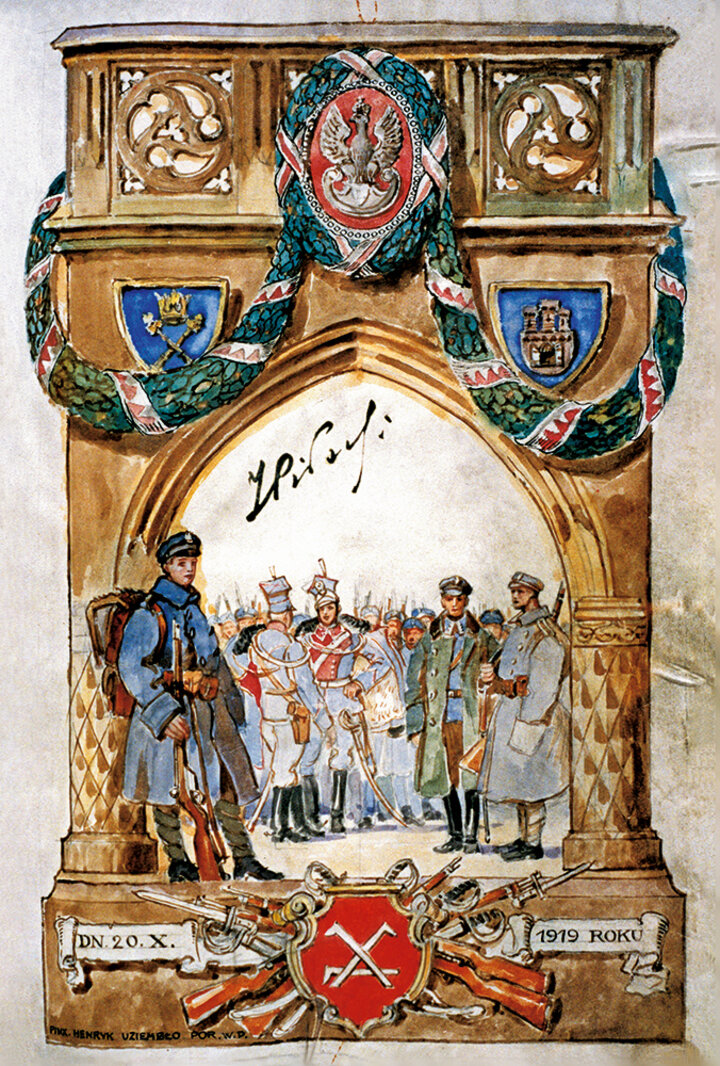The efforts to establish a Polish mining school in Krakow and to appoint suitable teaching staff began in the second half of the 19th century and intensified when Galicia gained autonomy in 1860. Numerous projects were developed that considered, among other things, the creation of an independent mining academy or a faculty of mining at the Lviv Polytechnic or the Technical Institute in Krakow.
At the beginning of the 20th century, a group of prominent engineers and mining activists, led by Jan Zarański, went to great lengths to obtain approval for establishing a higher education institution in Krakow to educate mining engineers. Concentrated diplomatic action was taken in Vienna to win the favour of the Austrian government.
These efforts were successful, and on July 10, 1912, Krakow authorities received
a permit to establish a mining academy.
In April 1913, the Ministry of Civil Engineering in Vienna appointed the Organising Committee of the Mining Academy in Krakow, chaired by Professor Józef Morozewicz. The document that confirmed the establishment of a higher school of mining in Krakow was signed on May 31, 1913 by emperor Franz Joseph I of Austria.
The outbreak of World War I made it impossible to inaugurate the first academic year of the newly-established academy in October 1914. The minutes from a conference at the President of Krakow, Juliusz Leo, contain a footnote related to the Mining Academy. A magistrate official, probably reorganising documents, wrote an additional note at the bottom of one of them that said: ‘Due to the outbreak of war, the Mining Academy was not opened, the whole matter being postponed to more peaceful times, 21st March 2015.’

When Poland regained its independence in 1918, the Organising Committee of the Mining Academy in Krakow recommenced its work.
On April 8, 1919, the Council of Ministers put forward an official motion to establish and open the Mining Academy in Krakow.
On May 1, 1919, the first six professors of the Mining Academy were appointed.
On October 20, 1919, Józef Piłsudski officiated a celebratory inauguration of the Mining Academy in the main hall of the Jagiellonian University.
From September 1929 to March 1930, the main building was gradually filled with departments and central administration of the academy. In 1935, the building was officially and ceremonially blessed. The Main Building of the Mining Academy assumed its final shape shortly before the outbreak of World War II. The construction is a perfect example of academic classicism, in style in the 1920s in Poland, which constitutes a manifestation of the power and might of the reborn Polish state. The façade decoration was complemented by monumental statues of miners and metallurgists. The figures were made in 1935 by the sculptor Jan Raszka. On August 24, 1939, the top of the building was crowned with the statue of Saint Barbara made by Stefan Zbigniewicz.
The Nazi German invasion of Poland in September 1939 brought the university to a halt. On September 6, Krakow was seized by German troops. They began to loot and plunder the university property, and reorganise the Main Building of the Mining Academy to house the Regierung des Generalgouvernements (General Government administration). In 1940, the statue of Saint Barbara was thrown off the top of the main building and shattered to pieces.
On September 6, 1939, a general assembly of Jagiellonian University professors was called to inform them about the policy of German authorities on science and education. On this day at noon, in room 66 of the JU Collegium Novum, professors and lecturers gathered numerously. The building was surrounded by the Gestapo and the meeting participants were arrested. Among the detainees were also Mining Academy professors who had attended another meeting in the boardroom of the JU Faculty of Philosophy. 183 people were imprisoned, among them professors, associate professors, and assistants from both universities, as well as many other people outside the academic community.
The arrested were detained at the prison at Montelupich Street in Krakow and subsequently transferred to the barracks at Mazowiecka Street. Later, they were transported to a prison in Wrocław and finally to the concentration camp in Sachsenhausen.
The concentration camp took the lives of the following:
Others who remained in the camp were Andrzej Bolewski, Stanisław Gołąb, and Julian Kamecki. They were transported to the concentration camp in Dachau and released only in the last quarter of 1940. Releasing the professors was possible due to a united protest action of world scientific communities.
Among the victims murdered by the NKVD on the territory of the Soviet Union between April and May 1940 were three Mining Academy employees:
Forced by the Germans, but with the consent of the Polish government in London and the Polish Underground State, in 1943, more than a dozen Poles went to Katyn, including the writer Ferdynand Goetel (secretary of the Mining Academy between 1920 and 1925, brother of Professor Walery Goetel). The committees corroborated that the massacre of Polish officers was executed by the Soviets. After the war, Ferdynand Goetel was to the Soviets one of the most inconvenient witnesses of the Katyn massacre.
Thanks to the generosity and dedication of the Mining Academy employees, the collection of the MA Main Library was safely deposited in the Jagiellonian Library. Academy activities had to go underground, and the governance attempted to reclaim or establish makeshift teaching venues and educational materials.
With the consent of the occupier, in 1940, a State School of Mining, Metallurgy, and Measurement (Staatlische Fachschule für Berg- Hütten- und Vermessungwesen) was established with Polish as the language of instruction. Professor Walery Goetel took the position of the head teacher; other professors from the closed Mining Academy became teachers. Both professors and assistants were also involved in underground education, lecturing, and teaching classes for academic students. During the underground schooling action, 278 examinations and 16 diploma exams took place.